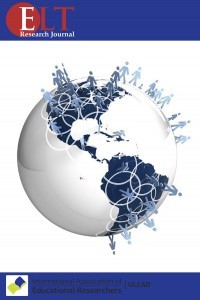Teachers’ Declared Beliefs and Actual Classroom Practices: A Case Study with Five EFL Teachers
Teachers’ Declared Beliefs and Actual Classroom Practices: A Case Study with Five EFL Teachers
The correlation between teachers’ beliefs and their actual classroom application have a critical impact on grammar teaching; therefore, a descriptive analysis of these two terms can provide the necessary information about how to improve teaching and learning process in an effective manner and help teachers eliminate the problems in English grammar teaching. This study aims to analyze the beliefs and practices of EFL teachers in grammar teaching in general and to see the effects of their professional backgrounds or school environment on their beliefs. It also aims to show the reflection of their declared beliefs on their real classroom practices. The data is collected by utilizing a beliefs questionnaire (open-ended questions), initial interview adapted by Mohammed (2006) and by designing an original classroom observation sheet for five EFL teachers with different qualities. Their answers were scrutinized and analyzed by using content analysis to see the differences between their declared and actual classroom practices. All differences were endorsed and compared in a table. Accordingly, there occurred some discrepancies between their declared beliefs and actual classroom performances in terms of grammar teaching.
___
- Borg, S. (1999). Studying teacher cognition in second language grammar teaching. System, 27(1), 19-31.
- Borg, S. (2003). Teacher cognition in language teaching: a review of research on what language teachers think, believe, know and do. Language Teaching, 36, 81-39.
- Farrell, T.S.C. & Lim, P.C.P. (2005). Conceptions of grammar teaching: A case study of teachers’ beliefs and classroom practices. TESL-EJ, 9(2), 1-13.
- Johnson, K. E. (1999). Understanding language teaching: Reasoning in action. Boston: Heinle & Heinle
- Ng, E.K.J., & Farrell, T.S.C. (2003). Do teachers’ beliefs of grammar teaching match their classroom practices? A Singapore case study. In D. Deterding, E.L. Low & A. Brown (Eds.), English in Singapore: Research on grammar (pp. 128-137). Singapore:McGraw Hill.
- Pajares, M. F. (1992). Teachers' beliefs and educational research. Review of Educational Research, 62(3), 307 - 332.
- Patton, M. Q. (2002). Qualitative research and evaluation methods (3rd ed.). Thousand Oaks, CA: Sage.
- Richardson, V. (1996). The role of attitudes and beliefs in learning to teach. In J. Sikula (Ed.), Handbook ofresearch on teacher education (2nd Edition ed., pp. 102-119). New York: Macmillan.
- Rokeach, M. (1968). Beliefs, attitudes, and values: A theory of organization and change. San Francisco: Jossey-Bass
- Nunnan,D.(2001)Research methods in language learning: Cambridge University Press Uysal,H.H.&Bardakci,M.(2014).Teacher Beliefs and Practices of Grammar Teaching: Focusing on Meaning, Form or Forms? South African Journal of Education, 34(1)
- Uztosun, M. S. (2013b). An ,interpretive study into elementary school English teachers' beliefs and practices in Turkey. Turkish Online Journal of Qualitative Inquiry, 4, 20-33.
- Yayın Aralığı: Yılda 2 Sayı
- Başlangıç: 2012
- Yayıncı: Uluslararası Eğitim Araştırmacıları Derneği
